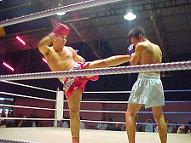|
Pradel Serey or Kbachkun
Pradal Khmer is the Cambodian style of an Indochinese martial art practised
in several Southeast Asian countries. It is a sibling of arts such as Muay
Thai from Thailand, tomoi from Malaysia, muay Lao from Laos, and a similar
style called lethwei from Myanmar. The term pradal serey means free
fighting, from the Khmer words pradal (fight/boxing) and serey (free).
|
 |
|
Originally used for warfare,
pradal serey is now one of Cambodia's national sports. Its moves have been
slightly altered for the modern ring sport.Pradal serey is the same as
kbachkun boran except it does not include mae ("core techniques"), tvear
(door system that emphasizes footwork) or weapons. Instead, it focuses more
on winning a bout. While most well-known for its kicking technique, which
generates power from hip rotation rather than snapping the leg, pradal serey
consists of four types of strikes: punches, kicks, elbows and knee strikes.
The clinch is also used to wear down the opponent. Compared to other forms
of Southeast Asian kickboxing, pradal serey tends to emphasize more elusive
and shifty fighting stances. The Cambodian style also tends to utilize more
elbow techniques than that of other regions. More victories come by way of
an elbow technique than any other strikes.
Match Setup
A match consists of five three-minute rounds and takes place in a 6.1 meter
square boxing ring. A one-and-a-half or two minute break occurs between each
round. At the beginning of each match boxers practice the praying rituals
known as the twai kru. Traditional Cambodian music performed with the
instruments skor yaul (a type of drum), the sralai (reed flute) and the
chhing, is played during the match. Modern boxers wear leather gloves and
nylon shorts.
Rules
A boxer is not allowed to strike his opponent while he is on the ground.
A boxer is not allowed to bite.
When an opponent can not fight anymore, the referee stops the fight.
Blows to the back of the opponent are not allowed.
A boxer may not hold on to the ropes.
Blows to the genitals are prohibited.
Victory can be obtained by knockout. A knockout occurs when a boxer is
knocked down to the ground and can not continue fighting after a 10 second
count by the referee, a referee may forgo the count and declare a knockout
if it is obvious the boxer will not regain his feet unaided. Victory is also
obtained from the end of the match when judges decide by a point system
which fighter was more effective. If fighters end up with the same score a
draw is called. |













